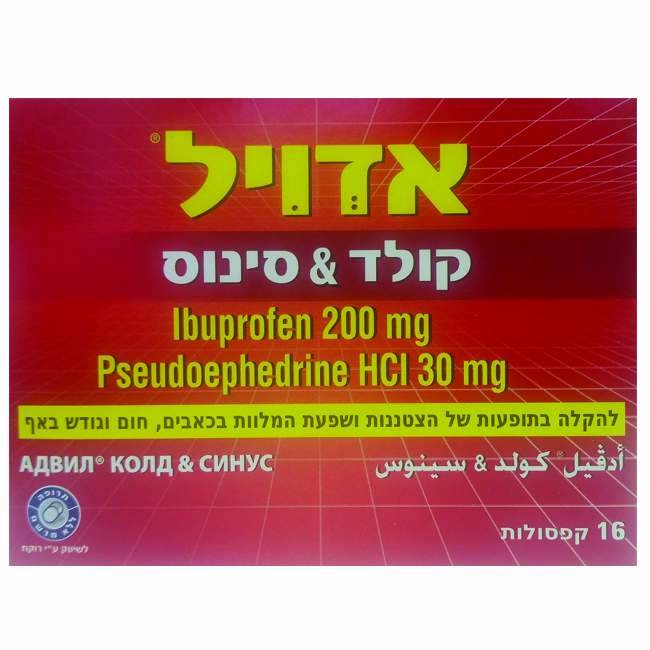Quest for the right Drug

אדויל קולד & סינוס ADVIL COLD & SINUS (IBUPROFEN, PSEUDOEPHEDRINE HYDROCHLORIDE)
תרופה במרשם
תרופה בסל
נרקוטיקה
ציטוטוקסיקה
צורת מתן:
פומי : PER OS
צורת מינון:
קפסולות ממולאות נוזל : CAPSULES LIQUID FILLED
עלון לרופא
מינוניםPosology התוויות
Indications תופעות לוואי
Adverse reactions התוויות נגד
Contraindications אינטראקציות
Interactions מינון יתר
Overdose הריון/הנקה
Pregnancy & Lactation אוכלוסיות מיוחדות
Special populations תכונות פרמקולוגיות
Pharmacological properties מידע רוקחי
Pharmaceutical particulars אזהרת שימוש
Special Warning עלון לרופא
Physicians Leaflet
Pharmacological properties : תכונות פרמקולוגיות
Pharmacodynamic Properties
5.1 Pharmacodynamic properties Pharmacotherapeutic group: Propionic acid derivatives, ibuprofen combinations ATC code: M01AE51 Ibuprofen is a non steroidal anti-inflammatory agent belonging to the Propionic Acid class of drugs that has demonstrated its efficacy by inhibition of prostaglandin synthesis. It has analgesic, antipyretic and anti-inflammatory properties. Pseudoephedrine Hydrochloride is a sympathomimetic agent which causes vasoconstriction of nasal mucosa, thereby reducing rhinorrhoea and nasal congestion. Experimental data suggest that ibuprofen may competitively inhibit the effect of low dose acetylsalicylic acid on platelet aggregation when they are dosed concomitantly. Some pharmacodynamics studies show that when single doses of ibuprofen 400 mg were taken within 8 h before or within 30 min after immediate release acetylsalicylic acid dosing (81 mg), a decreased effect of acetylsalicylic acid on the formation of thromboxane or platelet aggregation occurred. Although there are uncertainties regarding extrapolation of these data to the clinical situation, the possibility that regular, long term use of ibuprofen may reduce the cardioprotective effect of low-dose acetylsalicylic acid cannot be excluded. No clinically relevant effect is considered to be likely for occasional ibuprofen use (see section 4.5).
Pharmacokinetic Properties
5.2 Pharmacokinetic properties Ibuprofen is rapidly absorbed following administration and is rapidly distributed throughout the whole body. The excretion is rapid and complete via the kidneys. Absorption Ibuprofen is rapidly absorbed from the gastrointestinal tract following administration. Maximum plasma concentrations occur about 1 to 2 hours after ingestion. Time for peak plasma concentrations to be reached may vary depending on dosage form and whether taken with food. In an oral bioavailability study comparing solubilised ibuprofen (in the ibuprofen + pseudoephedrine Liqui-gel capsules formulation) was shown to be bioequivalent to the ibuprofen plus pseudoephedrine tablet, and ibuprofen soft capsule for ibuprofen extent of exposure (AUC). The combination soft capsule formulation had greater peak exposure (Cmax) to ibuprofen than the tablet formulation. In addition, median time to peak exposure (Tmax) was comparable between ibuprofen + pseudoephedrine Liqui-gel capsules (39 min) and comparator ibuprofen Liqui-gel capsules (45 min), and was 20-30 minutes shorter than comparator ibuprofen + pseudoephedrine tablets (67.5 min). The solubilized ibuprofen (as present in ibuprofen +pseudoephedrine Liqui-gel capsules) displays a faster systemic absorption rate versus the comparator combination ibuprofen + pseudoephedrine tablet formulation. Pseudoephedrine (in immediate release formulations) is readily absorbed from the gastrointestinal tract with peak plasma levels at 1-3 hours. Distribution Ibuprofen is primarily metabolized in the liver to primary metabolites 2-Hydroxyibuprofen and 2- Carboxyibuprofen. Ibuprofen is 90 to 99% bound to plasma proteins. In limited studies, Ibuprofen appears in the breast milk at very low concentrations. Pseudoephedrine is thought to cross the placenta and to enter cerebrospinal fluid Pseudoephedrine distributes into breast milk; about 0.5% of an oral dose is distributed into breast milk over 24 hours. Elimination Ibuprofen has a plasma half-life of about 2 hours. It is rapidly excreted in the urine mainly as metabolites and their conjugates. About 1% is excreted in the urine as unchanged ibuprofen and about 14% as conjugated ibuprofen. Pseudoephedrine is excreted largely unchanged in the urine with small amounts of its hepatic metabolite. It has a half-life of about 5 to 8 hours; elimination is enhanced and half-life accordingly shorter in acid urine. Small amounts are distributed into breast milk.

שימוש לפי פנקס קופ''ח כללית 1994
לא צוין
תאריך הכללה מקורי בסל
לא צוין
הגבלות
לא צוין
מידע נוסף
